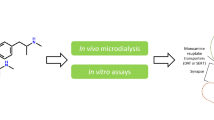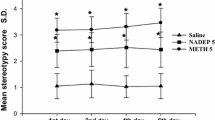Abstract
METHADONE, a synthetic narcotic with many similarities to morphine, is currently being used extensively as a crucial part of treatment-rehabilitation programmes for heroin addiction. In the doses used for “methadone maintenance”, this compound has minor tranquillizing effects, blocks the euphoric effects of heroin, eliminates drug craving, and prevents narcotic withdrawal symptoms. Although the mechanism of action of methadone is unknown, there are a number of recent reports which suggest that 5-hydroxytryptamine (serotonin) is involved in the perception of pain and in the mechanism of action of narcotic analgesics. For instance, Tenen first showed that p-chlorophenylalanine, which depletes tissues of serotonin by inhibiting synthesis, lowered the pain threshold of rats as measured by a flinch-jump technique1. He further found that p-chlorophenylalanine pretreatment lowered the analgesic effect of several major narcotics, including morphine and methadone2. Lints and Harvey made lesions in the medial forebrain bundle, septal area, and dorsomedial tegmentum of rats and concluded that the resulting increased sensitivity to electric shock and decreased telencephalic serotonin content were causally related3. Both effects were reversed by L-5-hydroxytryptophan but not by L-dihydroxyphenylalanine4. Rogers and Thornton showed that increased serotonin levels (but not dopamine or norepinephrine levels) were highly correlated with increased toxicity of principal narcotic analgesics following monoamine oxidase inhibitors5. Way et al. found that chronic morphinization of mice followed by pargyline administration resulted in a more rapid rise in brain serotonin compared with controls6. These investigators also showed that tolerance of and physical dependence on morphine in these animals was antagonized by p-chlorophenylalanine pretreatment and related the effects of morphine on serotonin metabolism to the development of tolerance and physical dependence. Haubrich and Blake found increased 5-hydroxyindoleacetic acid (5HIAA) in rat brain after acute and chronic doses of morphine7. These studies strongly support the idea that sensations of pain and certain effects of narcotic analgesics are mediated by serotoninergic systems. To compare methadone to morphine with regard to serotonin metabolism we performed the following experiments.
Similar content being viewed by others
References
Tenen, S. S., Psychopharmacologia, 10, 204 (1967).
Tenen, S. S., Psychopharmacologia, 12, 278 (1968).
Lints, C. E., and Harvey, J. A., J. Comp. Physiol. Psychol., 67, 23 (1969).
Lints, C. E., and Harvey, J. A., Physiol. Behav., 4, 29 (1969).
Rogers, K. J., and Thornton, J. A., Brit. J. Pharmacol., 36, 470 (1969).
Way, E. L., Loh, H. H., and Shen, F., Science, 162, 1290 (1968).
Haubrich, D. R., and Blake, D. E., Fed. Proc., 793 (1969).
Sheard, M. H., and Aghajanian, G. K., J. Pharmacol. Exp. Ther., 163, 425 (1968).
Tozer, T. N., Neff, N. H., and Brodie, B., J. Pharmacol. Exp. Ther., 153, 177 (1966).
Sharman, D. F., Brit. J. Pharmacol. Chemother., 30, 620 (1967).
Takagi, H., and Kuriki, H., Intern. J. Neuropharmacol., 8, 195 (1969).
Eidelberg, E., and Schwartz, A. S., Nature, 225, 1152 (1970).
Sharman, D. F., Brit. J. Pharmacol. Chemother., 28, 153 (1966).
Author information
Authors and Affiliations
Rights and permissions
About this article
Cite this article
BOWERS, M., KLEBER, H. Methadone increases Mouse Brain 5-Hydroxyindoleacetic Acid. Nature 229, 134–135 (1971). https://doi.org/10.1038/229134a0
Received:
Issue Date:
DOI: https://doi.org/10.1038/229134a0
- Springer Nature Limited
This article is cited by
-
Dual action of methadone on 5-HT synthesis and metabolism
Naunyn-Schmiedeberg's Archives of Pharmacology (1979)
-
Analgesic effect of etorphine in rats with selective depletions of brain monoamines
Psychopharmacology (1978)
-
Effect of midbrain raphe lesion on the antinociceptive action of morphine and other analgesics in rats
Psychopharmacologia (1973)
-
Decreased antinociceptive activity of morphine in rats pretreated intraventricularly with 5,6-dihydroxytryptamine, a long-lasting selective depletor of brain serotonin
Psychopharmacologia (1973)
-
5-Hydroxytryptamine in platelets and brain of rabbits treated chronically with imipramine, morphine or methadone
Naunyn-Schmiedeberg's Archives of Pharmacology (1973)





